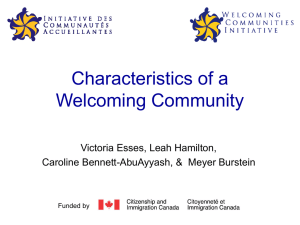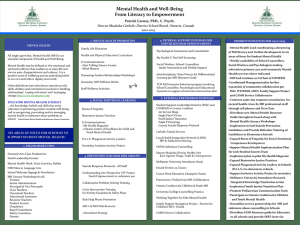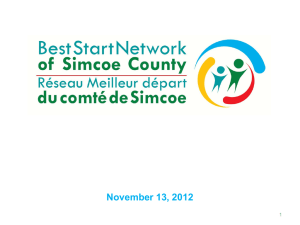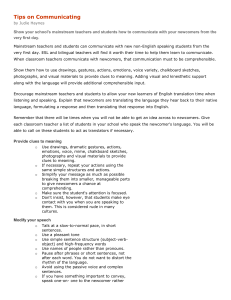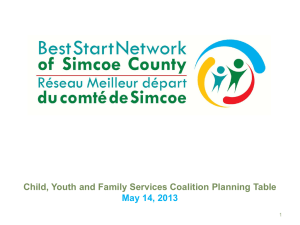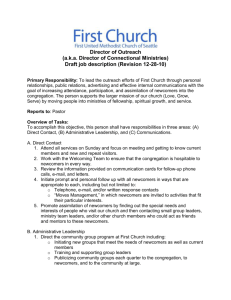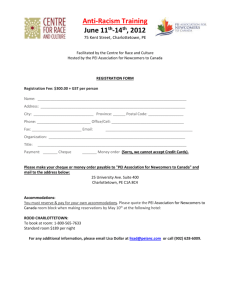WELCOMING COMMUNITIES FRAMEWORK
advertisement
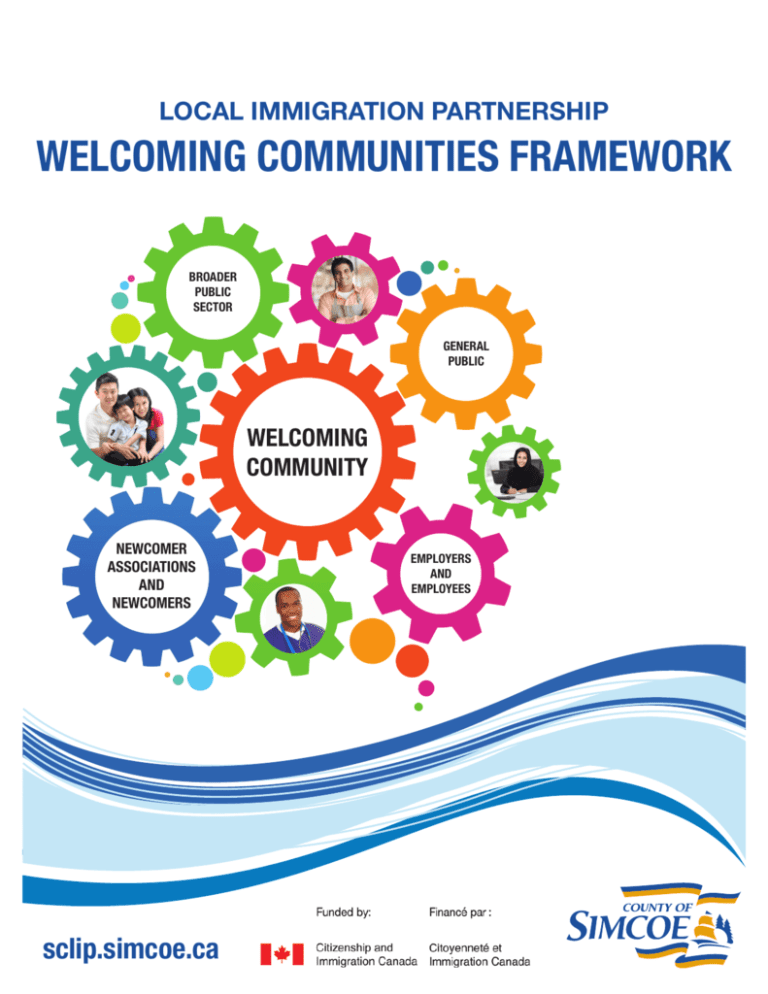
LOCAL IMMIGRATION PARTNERSHIP WELCOMING COMMUNITIES FRAMEWORK BROADER PUBLIC SECTOR GENERAL PUBLIC WELCOMING COMMUNITY NEWCOMER ASSOCIATIONS AND NEWCOMERS sclip.simcoe.ca EMPLOYERS AND EMPLOYEES Welcoming Communities Framework Table of Contents Message from the Warden Message from the Partnership Council Acknowledgements Introduction General Public 2 3 4 5 8 Residents of Simcoe County not pertaining to a single group or organization. Broader Public Sector 11 Organizations such as: hospitals, community health centres, schools, colleges, and universities, and the wide spectrum of human services offered in Simcoe County. Employers and Employees Business owners of small, medium to large enterprises, human resource staff, and Boards of Directors. Newcomers Associations and Newcomers 15 18 Ethno-cultural and faith-based organizations, provincial and federally funded settlement agencies/organizations, agencies or organizations that support newcomer settlement and integration, residents of Simcoe County who were born outside of Canada. SOCIAL AND COMMUNITY SERVICES Page 1 Welcoming Communities Framework Message from the Warden As the County of Simcoe continues to grow, many newcomers will choose to call our region home, and we want to ensure these residents feel welcome as they establish roots in their new community. The communities that embrace these newcomers will benefit from an enhanced labour force, economic development opportunities, increased cultural exposure, and a larger tax base. That is why the County of Simcoe was pleased to have been approached by Citizenship and Immigration Canada in April 2011 to establish our own Local Immigration Partnership. The County’s Local Immigration Partnership, one of 35 in Ontario, acts as a vital component in the development of local partnerships and community-based planning around the needs of newcomers. The Local Immigration Partnership is comprised of community leaders from across Simcoe County. These partners are actively involved in the Local Immigration Partnership Council, and six sub-councils: Employment, Education, Settlement, Human Services, and Welcoming Communities, as well as multiple working groups. More than 200 community organizations are working directly with the Local Immigration Partnership in some capacity. In October 2012, the Simcoe County Local Immigration Partnership launched the Community Settlement Strategy to provide a guide for the community to develop pathways to establish Simcoe County as a welcoming community. The Welcoming Communities Framework was developed in consultation with numerous stakeholders in response to the recommendation in the Community Settlement Strategy to strengthen public services by developing a public education strategy to reduce discrimination and racism, while encouraging cultural competency. The County of Simcoe is thankful to the many community partners whose ideas have helped implement strategies that will improve outcomes for our region’s newcomers. Cal Patterson Warden County of Simcoe Page 2 SOCIAL AND COMMUNITY SERVICES Welcoming Communities Framework Message from the Partnership Council The Simcoe County Local Immigration Partnership Council is pleased to share this framework with our community to offer further context to the dialogue started with the launch of the Community Settlement Strategy. Our communities are becoming increasingly diverse. Changing demographics are most apparent in the communities that form the southern part of the County but are observed in every municipality in Simcoe County. Our part of Ontario is projected to grow, and in Canada, immigration trends mirror community growth. The Simcoe County Local Immigration Partnership engaged municipalities throughout the region in 2013 with presentations on changing community demographics and to share the Community Settlement Strategy. The Partnership Council encourages all communities to use the strategy as a resource for their own strategic planning purposes. The Welcoming Communities Framework addresses our needs for a strategy to support newcomers living in Simcoe County and breaks down the roles of stakeholders in our community. We all play a vital role in the development of a welcoming home for newcomers. Alison Pickard Executive Director United Way Richard Milne Councillor County of Simcoe Partnership Council Co-Chair Partnership Council Co-Chair “Leave the beaten track behind occasionally and dive into the woods. Every time you do you will be certain to find something you have never seen before.” ~ Alexander Graham Bell ~ SOCIAL AND COMMUNITY SERVICES Page 3 Welcoming Communities Framework Acknowledgements The co-ordination of this project was directed by the Welcoming Communities Sub-Council who compiled the content and ensured the relevance of the work and consulted with: • • • • • Employment Sub-Council Human Services Sub-Council Settlement Sub-Council Education Sub-Council Business Development Sub-Council The Local Immigration Partnership wishes to extend thanks to the many stakeholders who provided content and reviewed the revisions for this publication. THANK YOU Page 4 SOCIAL AND COMMUNITY SERVICES Welcoming Communities Framework Introduction Overview of Simcoe County Local Immigration Partnership The Simcoe County Local Immigration Partnership (SCLIP) is a community partnership focused on the development of settlement strategies for newcomers. These strategies will bring together and support service delivery to newcomers in Simcoe County, while promoting positive relationships, opportunities, and the effective use of local resources. SCLIP was established in April 2011 to begin community-based planning for residents and newcomers and is one of 35 Local Immigration Partnerships in Ontario funded by Citizenship and Immigration Canada (CIC). During the development of the local Settlement Strategy, consultations took place with newcomers, employers, and key stakeholders in the community. Four themes were identified to address the most common challenges facing newcomers in Simcoe County. The following four themes provide a blueprint for establishing Simcoe County as a welcoming community: • Readiness • Opportunity • Inspire • Celebrate Development of a Welcoming Framework for Simcoe County As detailed in Figure 1, the number of the direct landings in Simcoe County have been steadily increasing and will likely continue to do so as more immigrants settle here. The Ontario Ministry of Finance has identified that the majority of the projected population increase in Simcoe County will come from intraprovincial migration; new residents in Simcoe County who arrive from other parts of Ontario. Newcomers generally immigrate to the Greater Toronto Area (GTA) and choose to move to Simcoe County as a secondary or tertiary destination. The population of Simcoe County is projected to grow to 667,000 1 2 FIGURE 1 800 Number of immigrants In 2010, a total of 650 new immigrants settled directly in Simcoe County from their country of origin. This represented an increase of 260 residents annually (67%) since 2000.1 610 635 675 665 655 605 650 600 450 400 400 390 335 2000 2001 2002 2003 2004 2005 2006 2007 2008 2009 2010 residents by 2031.2 Research conducted by the LIP found a significant sense of isolation for newcomers living in Simcoe County, greater than that faced by newcomers living in other areas of Ontario where more supports are available, including transportation, and multicultural and settlement centres. Citizenship and Immigration Canada, 2010 Data Cube Ontario, Places to Grow, Schedule 7 SOCIAL AND COMMUNITY SERVICES Page 5 Welcoming Communities Framework Welcoming Communities Framework The Welcoming Communities Sub-Council (a • Identify and raise awareness of the role each working committee of the LIP) has developed group plays in creating a welcoming community a Welcoming Communities Framework that • Provide actions key players can use to promote identifies sector-specific roles and and support a welcoming community actions to establish Simcoe County • Inform key community BROADER as a welcoming community for PUBLIC stakeholders SECTOR newcomers. Newcomers are • Identify actions by willing to uproot themselves GENERAL PUBLIC community members that to find a better place to live seem realistic in today’s and the host community has working environment. a role in helping to retain WELCOMING newcomers by incorporating COMMUNITY The framework is designed welcoming and inclusive from an integrative practices. approach and identifies NEWCOMER EMPLOYERS ASSOCIATIONS four main stakeholder groups. The framework exists AND AND EMPLOYEES Newcomers at one point of to reduce racism and NEWCOMERS time in their settlement and discrimination and encourage integration process will come cultural competency. Its into contact with one, or all of these objectives are to: sectors, and the framework identifies • Identify key players to act as change the unique roles each group plays and provides agents in the community strategies and tips to build a welcoming community. How to Use the Framework The framework is split into four sections. The content is tailored for each stakeholder group and helps increase awareness of newcomer trends, community demographics and cultural competency practices. Each section also includes additional resources and a checklist. The checklist provides practical tips and suggestions to aid in the pursuit of becoming a welcoming community. Page 6 SOCIAL AND COMMUNITY SERVICES Welcoming Communities Framework Benefits of a Welcoming Community A welcoming community is “a place where there is a strong desire to receive newcomers and to create an environment in which they will feel at home.”3 A welcoming community attracts and retains newcomers by: • Identifying and removing barriers • Promoting a sense of belonging • Meeting diverse individual needs • Offering services that promote successful integration. Successful integration is defined as the “ability to contribute, free of barriers, to every dimension of Canadian life – economic, social, cultural and political.”4 Simcoe County is an attractive place to live, work, and explore, and consideration to culturally competent initiatives will add a new dimension of interest for those considering relocating here. Newcomers bring a wealth of opportunities, education, and global awareness that enhances the cultural fabric of a community. A welcoming community is a healthy and vibrant community in which all its members belong and are given equal opportunities to access services and contribute. Intercultural Association of Greater Victoria. (2007). Attracting and retaining immigrants: A tool box of ideas for smaller centres (2nd ed.). Retrieved from http://wiki.settlementatwork.org/wiki/Attracting_%26_Retaining_Immigrants:_A_Tool_Box_of_Ideas_for_Smaller_Centres 3 Esses, V., Hamilton, L., Bennett-AbuAyyash, C., and Burstein, M. (March 2010). Characteristics of a Welcoming Community. Retrieved from http://p2pcanada.ca/wp-content/uploads/2011/09/Characteristics-of-a-Welcoming-Community-11.pdf 4 SOCIAL AND COMMUNITY SERVICES Page 7 Welcoming Communities Framework General Public Simcoe County is a diverse, family-centric community that offers opportunities for quality work/life balance. In 2010, a total of 650 new immigrants settled in Simcoe County directly from their country of origin. That number represents an increase of 67% from the 260 direct landing newcomers residing in Simcoe County in 2000.5 The number of newcomers arriving directly in Simcoe County is small compared to the majority who move here after first immigrating to another community elsewhere in Canada. This trend suggests that Simcoe County is increasingly being recognized as a location of choice for newcomers. Newcomers bring with them a wealth of knowledge, education, and skills, and in some cases monetary resources to invest in our communities. An important aspect of the leadership necessary to retain newcomers lays with the general public to be welcoming and inclusive. A receptive host community contributes to vibrant neighbourhoods in which newcomers are included and recognized as integral to future economic growth and community development. Changing Communities Simcoe County is continuing to grow and the characteristics of our communities are changing. New businesses are opening, ethnic diversity is increasing, and new languages are being introduced. Understanding these changes helps prepare host communities to welcome and reach out to new residents. Newcomers leave behind family, friends, and networks, and may experience isolation after arriving to a new area. The opportunity to meet and connect with neighbours increases a newcomer’s sense of community and may help to ease the transition. Many of those moving to Simcoe County are either in the core working age group 6 (49% in 2010) or under the age of 25 (31% in 2010). This data reflects new residents who are likely families with children. 5 Citizenship and Immigration 6 Citizenship and Immigration Page 8 SOCIAL AND COMMUNITY SERVICES Welcoming Communities Framework Community Champions Community champions lead and inspire others to change. Champions include mentors, volunteers, and leaders that may advocate for social and systemic transformation. A newcomer’s adjustment to a new community requires both settlement and integration. Effective connections and referrals to community service agencies may help a new Canadian considerably. in initiatives for newcomers. The internet and social media provide today’s 2010 Age Demographics youth with an of Immigrants Arriving enhanced global Directly to Simcoe awareness. County Youth can help When it comes to integration, the general public (Source: 2010 CIC Data Cube) newcomers has a large role to play; especially seniors and youth. Ages 25-44: 49% Seniors are the custodians of traditional practices and build networks through Ages 0-24: 31% have a lot to offer newcomers who are interested in learning about Canadian heritage and culture. There personal relationships are examples of seniors’ groups in the community connecting with newcomer seniors’ groups. Informal and social media. Schools also play an important role in connecting newcomers by creating welcoming and programs such as these provide an opportunity to share and understand each other’s cultures and can be inclusive practices and integration programming. Newcomer youth who are connected with the passed down to younger generations. community will increase the confidence of their Youth also have an important role in creating a parents’ decision to live in Simcoe County. welcoming community. Youth represent the future of Simcoe County and can provide strong leadership Community Level Media There are many ways to include newcomers and demonstrate a welcoming community. Community celebrations and festivals can incorporate activities and traditions from diverse cultures and include foods and entertainment that typify diverse cultures. Community organizations and service clubs may wish to diversify their membership to align with the changing community. Service clubs may also consider supporting initiatives that allow youth to volunteer internationally or that financially support local newcomer initiatives. Positive media coverage can go a long way to dispel myths, challenge prejudices and break down barriers in the community. Media organizations can also provide leadership by helping to inspire newcomers to be active contributors in their communities. SOCIAL AND COMMUNITY SERVICES Many newcomer groups are active in the community; however, there is often little media coverage of their events. An increase in local news stories featuring newcomers and initiatives led by newcomers will help to raise the public profile of immigrants living in Simcoe County. Page 9 Welcoming Communities Framework Additional Resources for the Broader Public Sector Citizenship and Immigration Canada Community Connection – Local Information County of Simcoe Immigration Portal County of Simcoe Local Immigration Partnership Ministry of Citizenship and Immigration Ontario Ministry of Citizenship and Immigration Pathways to Prosperity: Canada www.cic.gc.ca www.infosimcoecounty.ca www.immigration.simcoe.ca www.sclip.simcoe.ca www.ontarioimmigration.ca www.citizenship.gov.on.ca www.p2pcanada.ca/redirect/ Developing a Welcoming Community Checklist for the General Public Develop opportunities for seniors to share their stories Increase media coverage of newcomers stories and initiatives Attend/participate at a local multicultural event Share Canadian experiences with newcomers Experiment with foods from other cultures Research where newcomers are coming from Invite a new neighbour for tea Avoid making assumptions - ask questions Develop an online club or group to connect newcomers with the community Teach a newcomer about local sports (hockey, skiing, golf) Page 10 SOCIAL AND COMMUNITY SERVICES Welcoming Communities Framework Broader Public Sector Number of Unique Non-Official Languages in Simcoe County (Source: Statistics Canada) 2001: 57 2006: 66 2011: 107 “Statistics Canada has observed changes in patterns of response to both the mother tongue and home language questions that appear to have arisen from changes in the placement and context of the language questions. Data users are advised to exercise caution when evaluating trends related to mother tongue and home language that compare 2011 Census data to those of previous censuses.” ~ Statistics Canada Government offices, academic institutions, health care providers, emergency service providers, libraries, educational institutions, and human services agencies work together to support the diverse needs of community members in Simcoe County. As the demographics of Simcoe County continue to change, organizations have a responsibility to determine how the change will impact their services and how they can adapt. Broader Public Sector and “Readiness” The first theme in the Community Settlement Strategy7 is ‘Readiness,’ which is defined as “attracting and retaining newcomers to Simcoe County by developing dynamic public services that meet their needs.” Research conducted with newcomer and community stakeholders through the Local Immigration Partnership found public transportation, awareness of employment services, access to affordable housing and culturally appropriate healthcare and education were seen as barriers to newcomer settlement in Simcoe County. A long-term goal of settlement and integration is for newcomers to become active participants (socially, economically, politically and culturally) of the community. The broader public sector has a stake in newcomer success through incorporating newcomer perspectives into their delivery models and developing strategies to address cultural needs and language barriers. Language Needs As organizations consider the needs of newcomers in service delivery models, the ability to serve clients in a non-official language of Canada (French/English) needs to be considered. Between 2006 and 2011 5,575 new residents reported their mother tongue to be a non-official language. This represents a 16% increase from 2006 to 2011, while the overall population rose by 6%.8 Newcomers may not be connecting with fundamental community services because of communication barriers. Incorporating interpretation and translation into an organization’s annual planning processes will increase accessibility of services to newcomer populations. 7 Local Immigration Partnership Community Settlement Strategy, 2012 8 Statistics Canada. 2011. Language Census Data. Statistics Canada Catalogue no. 98-314-XCB2011016, 98-314-XCB2011033, 97-555-XCB2006016, 95F-0339-XCB2001006. SOCIAL AND COMMUNITY SERVICES Page 11 Welcoming Communities Framework Connecting with Newcomers Local Ethno-Cultural and Faith-Based Groups in Simcoe County support newcomers in meeting each other and becoming better connected with the community. Human service agencies will build trust and rapport with local newcomers and communicate a clear message that newcomers are welcome by increasing outreach efforts to newcomer groups. The broader public sector has a mentoring role to play, supporting these agencies and further developing their capacity to serve their membership. Designating roles for newcomers on local boards of directors, as well as in networking groups and at community planning tables will ensure immigrant voices are heard and understood. Developing strategies to reach out to newcomers and promoting programs to immigrants also needs to be considered by the broader public sector as part of regular planning. Many newcomers are unaware of resources in our communities as services are often different than what was available in their country of origin. Without a Canadian reference point they may not know particular services available, processes involved or how to access them. Some newcomers may be interested in volunteerism or becoming involved in programs local agencies offer. Cultural Competency Training Sometimes when working with diverse populations, unexpected challenges may arise. Through cultural competency training, professionals in the human service sector will build confidence in their skills to serve newcomer populations. “Operationally defined, cultural competence is the integration and transformation of knowledge about individuals and groups of people into specific standards, policies, practices, and attitudes used in appropriate cultural settings to increase the quality of services; thereby producing better outcomes.” Davis, K. (1997). Exploring the intersection between cultural competency and managed behavioral health care policy: Implications for state and county mental health agencies. Alexandria, VA: National Technical Assistance Center for State Mental Health Planning. Cultural competency training provides an opportunity for staff to gain familiarity in working Page 12 with individuals from different cultures and helps build an awareness of experiences faced by newcomers. Agencies may choose to engage in a cultural competency self-assessment. This type of evaluation does not provide a pass or fail grade but rather a position along a continuum of development. Tools exist to help support agencies with this kind of organizational self reflection and may serve as an internal window to understand how welcoming an agency or service is to newcomers. Cultural competency is an on-going developmental process. Due to staff turnover and changes in delivery models, it is recommended agencies assess their development periodically. Local organizations can further communicate a welcoming service by considering the diversity of their staff profile and actively recruiting newcomers for position vacancies. SOCIAL AND COMMUNITY SERVICES Welcoming Communities Framework Effective Referrals Newcomer clients may identify a need beyond an agency’s regular service mandate. To ensure this need is addressed, a referral to a community based organization or program should be made. A referral ensures a client will be connected to an external agency to provide further care or service. A referral can be made to an agency providing settlement services. A settlement service agency or organization assists immigrants with settling and adjusting to life in Canada. Settlement services may include: assistance with immigration-related issues or documentation, housing and basic counselling support, language classes, and employment assistance. Settlement counsellors help support newcomers by connecting them with appropriate services and helping navigate complex service systems, which may be different from their country of origin. Additional Resources for the Broader Public Sector Barrie Public Library Bradford Immigrant & Community Services (BICS) Central Local Health Integration Network (LHIN) Cultural Competency Training & Resources Georgian College Occupation-Specific Language Training Library Co-operative (click ‘Members’ to find closest library) North Simcoe Muskoka Local Health Integration Network (LHIN) Orillia Public Library Simcoe County Local Immigration Partnership Simcoe County District School Board – English as a Second Language Program Simcoe County District School Board – International Languages After School Program Simcoe County District School Board – Newcomer Welcome Centre Simcoe Muskoka Catholic District School Board – English as a Second Language Simcoe Muskoka Catholic District School Board International Language Programs Welcome Centre Mobile Services YMCA of Simcoe/Muskoka Newcomer Services SOCIAL AND COMMUNITY SERVICES www.library.barrie.ca www.bradfordimmigrant.com www.centralhealthline.ca www.simcoe.ca/ws_cos/groups/public/@pub-cosccs/documents/web_content/wscos_044798.pdf www.georgiancollege.ca www.simcoe.ca/dpt/lib www.centralhealthline.ca www.orilliapubliclibrary.ca www.sclip.simcoe.ca www.thelearningcentres.com/learning-centresprograms/english-as-a-second-language www.thelearningcentres.com/learning-centresprograms/international-languages-program www.scdsb.on.ca/Schools/Pages/Newcomer.aspx www.smcdsb.on.ca/parents/ESL/ www.smcdsb.on.ca/cms/One. aspx?portalId=36&pageId=8926 www.welcomecentre.ca www.ymcaofsimcoemuskoka.ca Page 13 Welcoming Communities Framework Developing a Welcoming Community Checklist for the Broader Public Sector Develop a diversity committee Outreach to Ethno-Cultural and Faith-Based Groups Provide cultural competency training to management and frontline staff Develop volunteer opportunities for newcomers Include newcomers in organizations decision making process (e.g. Board of Directors) Incorporate translation and interpretation into annual budget planning During intake/assessment process be sure to ask a newcomer all languages they speak – one may be an official language of Canada Support/facilitate transportation education for newcomers (e.g. local buses, commuter trains) Page 14 Familiarize yourself with community agencies/ organizations in order to make effective referrals SOCIAL AND COMMUNITY SERVICES Welcoming Communities Framework Employers and Employees A large number of internationally trained professionals are finding work in Ontario and contribute to the growth of local businesses. Approximately 30% of the Ontario labour force are immigrants.9 In 2011, employment in Ontario among landed immigrants between the ages of 25-54 increased 4.3% from the previous year.10 Internationally trained professionals come from strong professional and educational backgrounds and can meet skills shortages needed by local employers. workers over the age of 55 than ever before. Close to one person out of four in the labour force is projected to be 55 years or over by 2021. This proportion was 16.9% in 2010.11 Employers in Simcoe County have communicated similar trends and concerns about filling employee vacancies.12 Increasing population diversity in Simcoe County will likely result in more foreign-born employees in the core working ages available to fill position vacancies and help develop local businesses. The Ontario labour market is more heavily reliant on Recognizing Talent Newcomers have identified challenges in having local employers recognize the education and experiences they obtained outside Canada.13 Employers who do not have experience assessing skills, talent and education from outside Canada may be unsure how to begin. There are many resources to support employers, such as www.hireimmigrants.ca and the Foreign Credentials and Referrals Office at www.credentials.gc.ca. Some internationally trained professionals may take part in bridging programs to improve skills and experiences acquired in different countries to meet Ontario employers expectations. Bridging programs provide training and workplace experience to ensure workers are prepared to succeed in the Ontario workforce, in both regulated and non-regulated professions. Another option for employers to consider is connecting with internship programs, such as Career Bridge. Internships provide employers with a cost-effective way to attract diverse, qualified talent. 9 Reasons to Consider Hiring Internationally Trained Professionals (Source: The Foreign Credentials and Referrals Office) • Meeting your labour needs • Increasing your business’s competitiveness • Developing new markets • Making your organization more effective • Connecting you with other valuable workers and organizations Statistics Canada. 2009. The Daily: Labour Force Survey. http://www.statcan.gc.ca/daily-quotidien/090206/dq090206a-eng.htm Statistics Canada. 2012. The Daily: Canada’s Immigrant Labour Market, 2008-2011 (part of The Immigrant Labour Force Analysis Series). Statistics Canada Catalogue no. 71-606-X. Version updated December 2012. Ottawa. http://www.statcan.gc.ca/daily-quotidien/121214/dq121214b-eng.htm 10 Statistics Canada. 2012. Canadian Economic Observer. Statistics Canada Catalogue no. 11-010-X. Ottawa. Version updated December 2012. Ottawa. http://www.statcan.gc.ca/pub/11-010-x/2011008/part-partie3-eng.htm 11 12 13 Local Immigration Partnership Community Settlement Strategy, 2012 Local Immigration Partnership Community Settlement Strategy, 2012 SOCIAL AND COMMUNITY SERVICES Page 15 Welcoming Communities Framework Mentoring Businesses may want to consider informal or formal mentorship programs in which newcomer employees are matched with experienced employees. Through mentorship, newcomers can ask questions, seek guidance and develop professional networks. Seasoned employees may be interested in sharing their employment experiences with newcomers. Employees Immigrant Entrepreneurs One of the top factors local employers consider when hiring new employees is, “fit within the organization.”14 Current employees have a role in demonstrating a welcoming workplace for newcomers and helping new employees fit into the work environment. Taking an interest in a new colleague, offering to support an employee orientation /mentoring program or encouraging participation on workplace committees allows employees to support new internationally trained professionals and contributes to maintaining a healthy workplace. In addition to coming to Ontario and finding meaningful employment, many newcomers come to Ontario and open businesses of their own, creating employment opportunities for other members of the community. Local Chambers of Commerce and business development resources can play a leadership role in connecting immigrant business owners with local business networks and supports. Immigrant Employment Council An economic immigrant is a person who is selected to immigrate to Canada based on his or her skills and other assets and is able to make an immediate contribution to Canada. In order to support the integration of skilled immigrant talent, Immigrant Employment Councils (IEC) have been created across the country. IEC’s are comprised of community stakeholders who support active immigrant labour 14 participation by creating local solutions to meet local labour needs. The Simcoe Muskoka Workforce Development Board (SMWDB) and the County of Simcoe are working collaboratively to develop a similar resource in Simcoe County. Contact the SMWDB at www.smwdb.com for more information. Digging Deeper: Learning from the Local Labour Market in Simcoe and Muskoka, Tom Zizys, 2012 Page 16 SOCIAL AND COMMUNITY SERVICES Welcoming Communities Framework To Learn More about Diversifying your Workplace Career Bridge Career Edge Citizenship and Immigration Canada Conference Board of Canada Cultural Competency Training & Resources Foreign Credentials and Referrals Office Greater Barrie Business Enterprise Centre Hire Immigrants Industry Canada Ministry of Citizenship and Immigration Ministry of Training, Colleges and Universities Ontario Human Rights Commission Simcoe County Immigrant Employment Council Simcoe Muskoka Workforce Development Board Skills International www.careeredge.ca www.careeredge.ca www.cic.gc.ca www.conferenceboard.ca www.simcoe.ca/ws_cos/groups/public/@pub-cosccs/documents/web_content/wscos_044798.pdf www.cic.gc.ca/english/department/fcro/index.asp www.barriebusinesscentre.ca www.hireimmigrants.ca www.ic.gc.ca www.citizenship.gov.on.ca www.tcu.gov.on.ca/eng/employmentontario www.ohrc.on.ca www.hireimmigrants.simcoe.ca www.smwdb.com www.skillsinternational.ca Developing a Welcoming Community Checklist for the Employers and Employees Review “roadmap” available at www.hireimmigrants.ca Review Human Resource policies to be inclusive of newcomers Develop or participate in a mentorship program Adapt recruitment strategies to better connect with newcomers Provide internship opportunities to newcomers Invite new colleagues to join you on break Learn more about bridging programs Host an employee potluck to share food from different cultures Encourage newcomer employees to join committees at work SOCIAL AND COMMUNITY SERVICES Consider multicultural holidays in workplace policies/planning Designate a prayer space at work Encourage newcomer entrepreneurs to join business networks Page 17 Welcoming Communities Framework Newcomer Associations and Newcomers As a community member in Simcoe County, immigrants are encouraged to continue using their talents and become involved in the community. There are a number of community agencies that assist newcomers with this transition and provide assistance during the settlement and integration process. Connecting with Newcomers and Advocacy Local Ethno-Cultural and Faith-Based Groups in Simcoe County connect immigrants to each other and often host celebrations from their culture. Many newcomers are connecting with the community through these groups. It is important for leaders of the Ethno-Cultural and Faith-Based Groups to be aware of the Community Settlement Strategy so they can become further involved in the planning of programs that affect their members. Services for Newcomers Sometimes newcomers experience unexpected challenges when moving into a new area. It takes time to settle into a new country and there are programs and services in Simcoe County that can help newcomers with the process. Settlement Services are designed to help immigrants settle and integrate into their new community. Through these programs, settlement staff can link newcomers with additional services to help ease their transition, address immediate and future needs. Some of these services include: child care subsidies, employment services, housing support services, and community health centres. Page 18 SOCIAL AND COMMUNITY SERVICES Welcoming Communities Framework Getting Involved in the Community The research conducted by the Simcoe County Local “Newcomers will integrate into a society that values Immigration Partnership with newcomers living in the experiences they bring with them, as well as this area shows immigrants possess a willingness and sharing in events that typify traditional Canadian interest in embracing and celebrating Canadian culture. culture.” There are many ways for newcomers to learn more Local Immigration Partnership Community Settlement Strategy 2012, about Canadian culture, mainly by becoming active in County of Simcoe community activities. Some ways to become involved in the community include volunteering, attending community events, participating in local politics, becoming active in a child’s school community, or joining a recreation/leisure group such as a sports team or interest group. Additional Resources for Newcomers Barrie Latin Resource Centre Barrie Public Library Bradford Immigrant & Community Services (BICS) www.barrielatinresource.ca www.library.barrie.ca www.bradfordimmigrant.com County of Simcoe Local Immigration Partnership Ethno-Cultural/Faith-Based Organizations Georgian College Occupation-Specific Language Training Information and Answers about Settling in Ontario and Canada Library Co-operative (click ‘Members’ to find closest library) Local Information on Program and Services Orillia Public Library Service Canada Service Ontario Simcoe County Immigration Portal Simcoe County District School Board – English as a Second Language Program Simcoe County District School Board – International Languages After School Program Simcoe County District School Board – Newcomer Welcome Centre Simcoe Muskoka Catholic District School Board – English as a Second Language www.sclip.simcoe.ca www.immigration.simcoe.ca/welcoming/culture www.georgiancollege.ca www.settlement.org SOCIAL AND COMMUNITY SERVICES www.simcoe.ca/dpt/lib www.communityconnection.ca www.orilliapubliclibrary.ca www.servicecanada.gc.ca www.ontario.ca/serviceontario www.immigration.simcoe.ca www.thelearningcentres.com/learning-centresprograms/english-as-a-second-language www.thelearningcentres.com/learning-centresprograms/international-languages-program www.scdsb.on.ca/Schools/Pages/Newcomer.aspx www.smcdsb.on.ca/parents/ESL/ Page 19 Welcoming Communities Framework Additional Resources for Newcomers Simcoe Muskoka Catholic District School Board International Language Programs Volunteer Connection Volunteer South Simcoe Welcome Centre Mobile Services YMCA of Simcoe/Muskoka Newcomer Services www.smcdsb.on.ca/cms/One. aspx?portalId=36&pageId=8926 www.volunteerconnection.ca www.volunteersouthsimcoe.ca www.welcomecentre.ca www.ymcaofsimcoemuskoka.ca Developing a Welcoming Community Checklist for Newcomers Visit your local library Become familiar with your local politicians Volunteer in the community Get involved in your child’s school community Participate in events hosted by newcomer associations Share your experiences with your neighbours Read your local newspaper Join a local service club such as the Lions or Rotary Enrol family members in a Parks and Recreation program (e.g. sports team, art class) Page 20 SOCIAL AND COMMUNITY SERVICES 1110 Highway 26, Midhurst, Ontario Main Line: (705) 735-6901 Toll Free: (800) 263-3199 simcoe.ca
